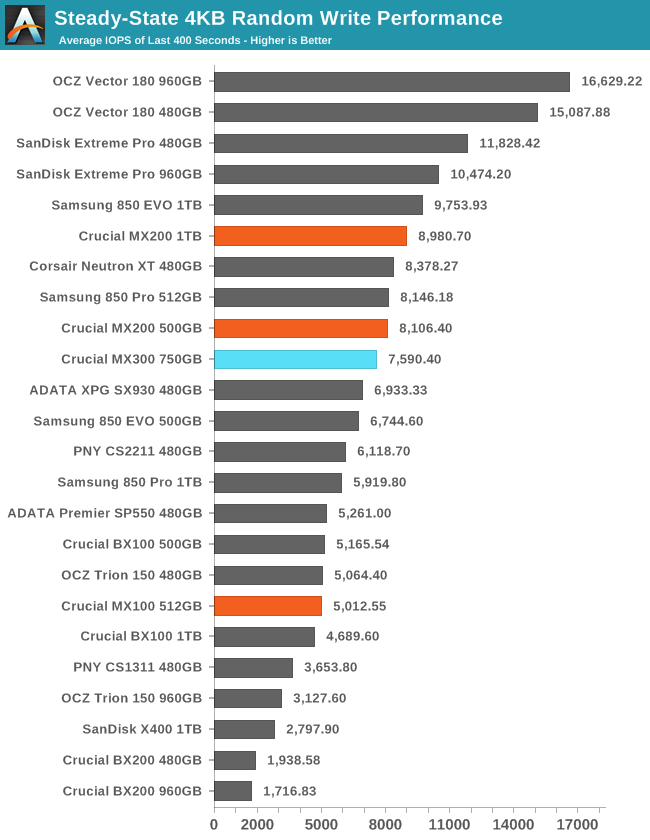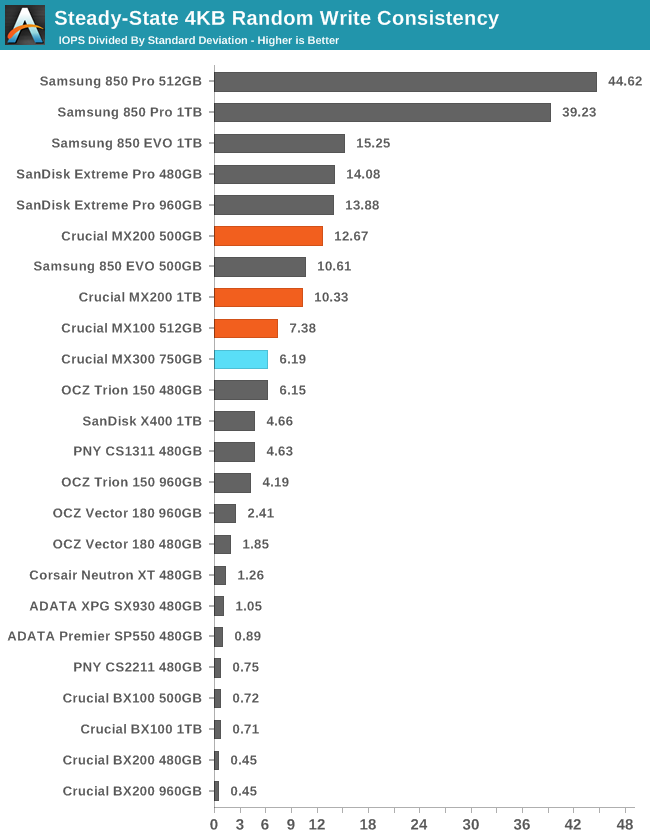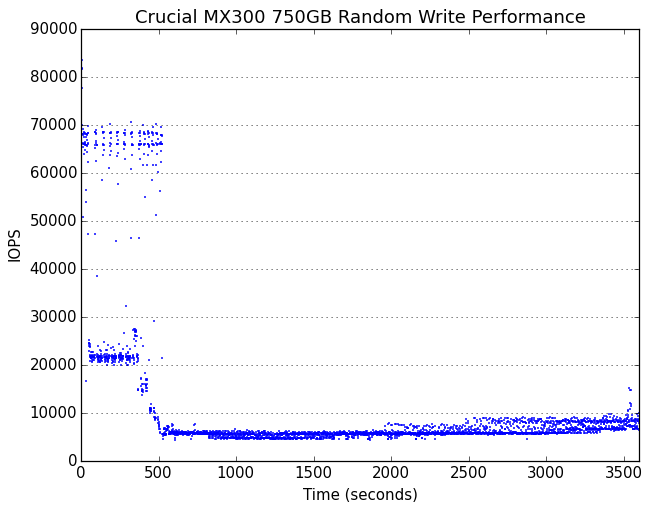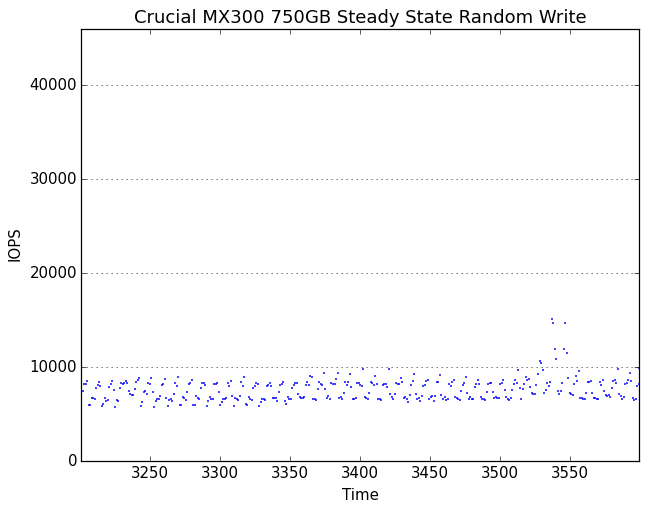The Crucial MX300 750GB SSD Review: Micron's 3D NAND Arrives
by Billy Tallis on June 14, 2016 9:00 AM ESTPerformance Consistency
Our performance consistency test explores the extent to which a drive can reliably sustain performance during a long-duration random write test. Specifications for consumer drives typically list peak performance numbers only attainable in ideal conditions. The performance in a worst-case scenario can be drastically different as over the course of a long test drives can run out of spare area, have to start performing garbage collection, and sometimes even reach power or thermal limits.
In addition to an overall decline in performance, a long test can show patterns in how performance varies on shorter timescales. Some drives will exhibit very little variance in performance from second to second, while others will show massive drops in performance during each garbage collection cycle but otherwise maintain good performance, and others show constantly wide variance. If a drive periodically slows to hard drive levels of performance, it may feel slow to use even if its overall average performance is very high.
To maximally stress the drive's controller and force it to perform garbage collection and wear leveling, this test conducts 4kB random writes with a queue depth of 32. The drive is filled before the start of the test, and the test duration is one hour. Any spare area will be exhausted early in the test and by the end of the hour even the largest drives with the most overprovisioning will have reached a steady state. We use the last 400 seconds of the test to score the drive both on steady-state average writes per second and on its performance divided by the standard deviation.

The MX300's steady state random write performance is below the MX200 but stays slightly ahead of the 850 EVO and well ahead of any planar TLC drive.

The MX300 earns a consistency score that is below the MX200 but about average, and certainly high enough for ordinary consumer workloads.
 |
|||||||||
| Default | |||||||||
| 25% Over-Provisioning | |||||||||
The MX300 lasts for over eight minutes before the SLC cache and spare area are completely exhausted, but during that phase it alternates between operating at about 22k IOPS and 65-70k IOPS. During the steady state phase there is gradual improvement in performance along with an increase in variability.
 |
|||||||||
| Default | |||||||||
| 25% Over-Provisioning | |||||||||
The steady state random write performance of the MX300 varies periodically between about 6k IOPS to 10k IOPS, with no outliers of slow performance. With extra overprovisioning performance is substantially higher and consistency is a bit better.










85 Comments
View All Comments
euskalzabe - Sunday, June 19, 2016 - link
Excellent reply, bravo.tonyman - Thursday, June 23, 2016 - link
To refute your point that "Nobody Uses SSDs for Cold Storage", I'll give a real-world counterexample... I make a machine vision system that I sell into a factory environment. I build the PCs that the system runs on, and sell it as a turnkey system. For reliability and performance, these PCs are equipped with SSDs as their boot and data drives. As this system, and therefore the PC it runs on, is mission critical, many customers purchase extra preconfigured PCs from us... which can sit around for several years before being used. Data retention on the boot drives of these cold-stored PCs is therefore quite a big issue... one I was ignorant of until a year or so ago, unfortunately. Oops.JKJK - Thursday, June 23, 2016 - link
Raid 0 for storage?Russian rulette ... catch you on the flipside.
sor - Tuesday, June 14, 2016 - link
The MX300 had best in class mixed read/write power performance, and close to the best in other power benchmarks. It seems to beat it's primary competitors (< $.30/GB) on performance, like the OCZ Trion. It could be a better value to make it an obvious buy, but it seems fair to me. It costs less and performs worse than the > $.30/gb range and costs more and performs better than the < $.25/GB.barleyguy - Tuesday, June 14, 2016 - link
"uses more power" isn't accurate. The power usage under load is flat out excellent.Byte - Tuesday, June 14, 2016 - link
Pricing average for 1TB(960GB) is about $200 (you can get ocz trion or silicon power at this price point every day, they are decent mainstream SSDs). This would need to be $150 to even be worth considering. If this had better performance maybe I can see it being worth more. I used a ton of Crucial SSDs and they are fine, but so are pretty much all the other brands i've used. I've only had 1 sandisk low end SSD die on me, and i've handled a few hundred.Gondalf - Wednesday, June 15, 2016 - link
Techreport (and Anandtech) say the contrary and i think they are a lot more reliable than you like hardware testers.TheinsanegamerN - Tuesday, June 14, 2016 - link
More power hungry, worse endurance, slower, and more expensive then the competition. Truly an amazing drive ! /sJoeyJoJo123 - Tuesday, June 14, 2016 - link
Oh no! Less SSD endurance! My current SSD gets winded after only 30 seconds of running! Whatever shall I do with typical consumer I/O workloads and less "endurance"!?[/sarcasm]kyuu - Tuesday, June 14, 2016 - link
Do people even read the article before posting negative crap anymore?It's not more power hungry. In fact, the article shows that it's quite power efficient.
I also hope you're not seriously comparing the MSRP of this drive versus the street prices of other drives. Street prices are always lower than the MSRP, especially in the SSD market.